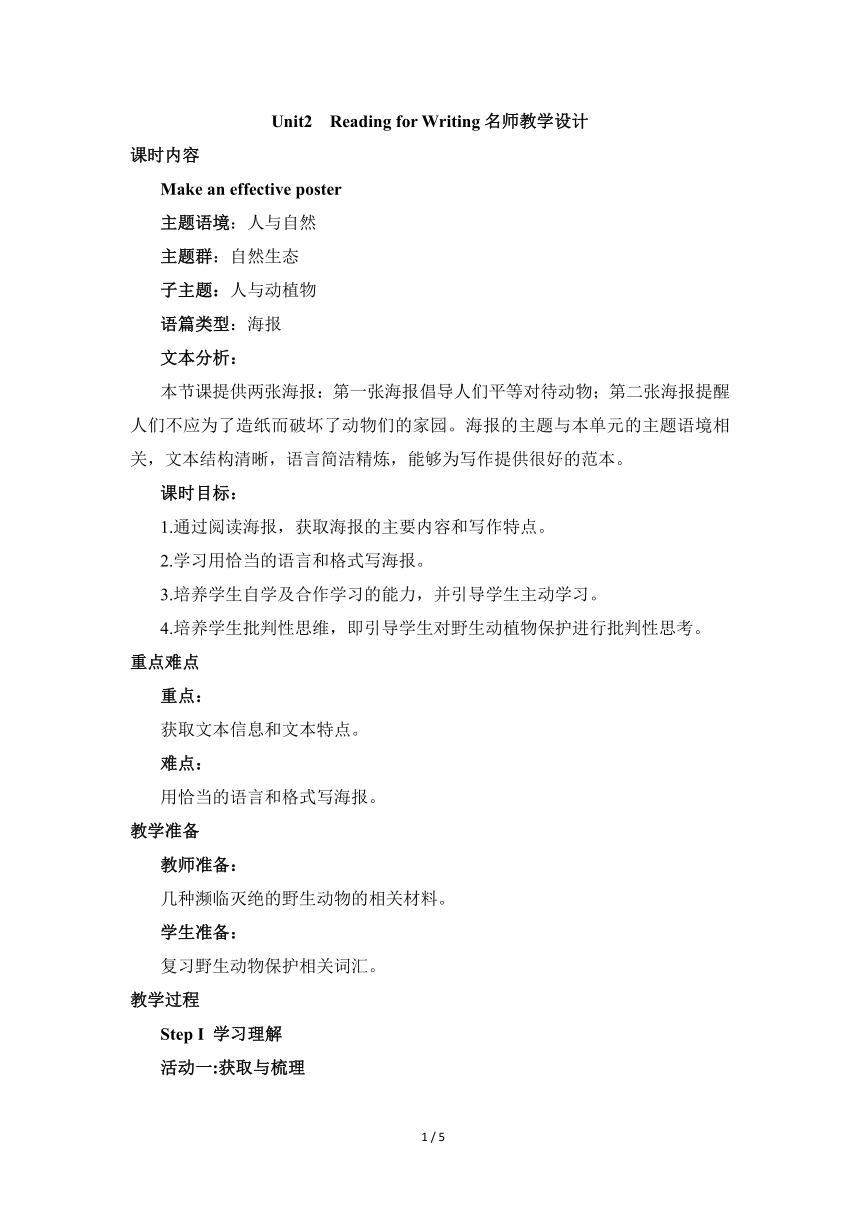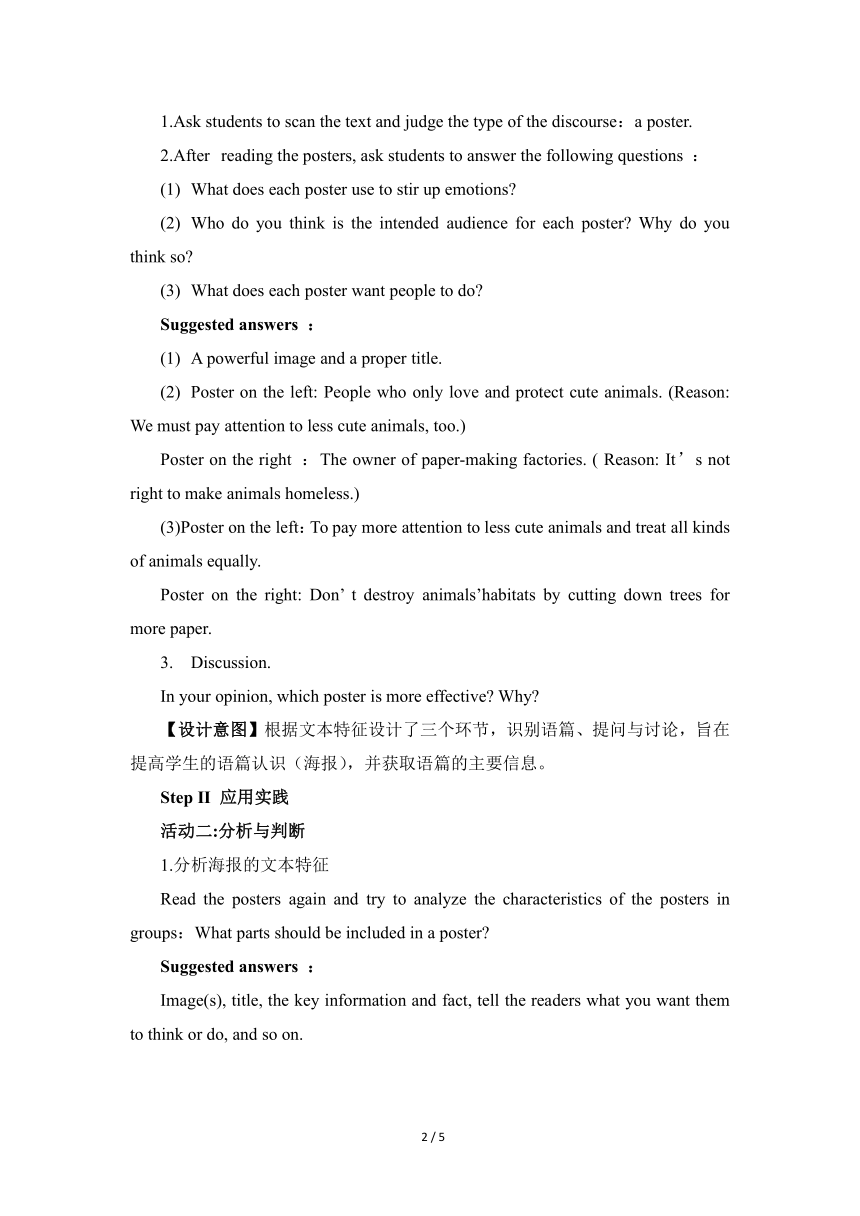人教版(2019)必修第二册 Unit2 Wildlife protection Reading for Writing名师教学设计
文档属性
| 名称 | 人教版(2019)必修第二册 Unit2 Wildlife protection Reading for Writing名师教学设计 |  | |
| 格式 | doc | ||
| 文件大小 | 77.1KB | ||
| 资源类型 | 教案 | ||
| 版本资源 | 人教版(2019) | ||
| 科目 | 英语 | ||
| 更新时间 | 2023-03-09 19:04:53 | ||
图片预览


文档简介
Unit2 Reading for Writing名师教学设计
课时内容
Make an effective poster
主题语境:人与自然
主题群:自然生态
子主题:人与动植物
语篇类型:海报
文本分析:
本节课提供两张海报:第一张海报倡导人们平等对待动物;第二张海报提醒人们不应为了造纸而破坏了动物们的家园。海报的主题与本单元的主题语境相关,文本结构清晰,语言简洁精炼,能够为写作提供很好的范本。
课时目标:
1.通过阅读海报,获取海报的主要内容和写作特点。
2.学习用恰当的语言和格式写海报。
3.培养学生自学及合作学习的能力,并引导学生主动学习。
4.培养学生批判性思维,即引导学生对野生动植物保护进行批判性思考。
重点难点
重点:
获取文本信息和文本特点。
难点:
用恰当的语言和格式写海报。
教学准备
教师准备:
几种濒临灭绝的野生动物的相关材料。
学生准备:
复习野生动物保护相关词汇。
教学过程
Step I 学习理解
活动一:获取与梳理
1.Ask students to scan the text and judge the type of the discourse:a poster.
2.After reading the posters, ask students to answer the following questions :
(1) What does each poster use to stir up emotions
(2) Who do you think is the intended audience for each poster Why do you think so
(3) What does each poster want people to do
Suggested answers :
(1) A powerful image and a proper title.
(2) Poster on the left: People who only love and protect cute animals. (Reason: We must pay attention to less cute animals, too.)
Poster on the right :The owner of paper-making factories. ( Reason: It’s not right to make animals homeless.)
(3)Poster on the left:To pay more attention to less cute animals and treat all kinds of animals equally.
Poster on the right: Don’ t destroy animals’habitats by cutting down trees for more paper.
3. Discussion.
In your opinion, which poster is more effective Why
【设计意图】根据文本特征设计了三个环节,识别语篇、提问与讨论,旨在提高学生的语篇认识(海报),并获取语篇的主要信息。
Step II 应用实践
活动二:分析与判断
1.分析海报的文本特征
Read the posters again and try to analyze the characteristics of the posters in groups:What parts should be included in a poster
Suggested answers :
Image(s), title, the key information and fact, tell the readers what you want them to think or do, and so on.
2.赏析语言
(1) Ask the students to read the text again and underline the sentences with the present continuous passive voice.
Suggested answers :
are being cut down;are being destroyed
(2)Complete the sentences below.
①Tiger s__________ (hunt) every year for the skin and fur.
②I’m sorry that some animals__________ (protect)well enough these days.
③It is reported that a plan__________ (carry out) at present to save the wildlife habitat.
Suggested answers :
are being hunted
② are not being protected
is being carried out
【设计意图】通过阅读课文、分析文本特征和赏析语言特征,让学生深度阅读,挖掘主题的意义,并学习语篇的写作特征。这个活动有助于提高学生对海报写作的认识和理解,为后续写作作铺垫。
活动三:实战演练
Make a poster about an endangered animal.
1.Brainstorm.
Ask the students to work in groups of four, choose one of the animals (South China Tiger and Yantze River Dolphin) , read the fact sheet, and talk about image(s), title, the key information and facts, tell the readers what you want them to think or do, and so on.
South China Tiger
Why is it endangered Hunted for its skin and fur
Population:0 in the wild;30 80 still living
What is being done A plan is being carried out to increase the number of wild tigers.
What can we do Do not buy fur or other tiger products!
Yangtze River Dolphin
Why is it endangered Habitat loss and pollution Population : 1,000 1,800
What is being done The dolphins are being moved to a clean and safe habitat.
What can we do Clean up the rivers!
2.Write the poster according to the brainstorm.
【设计意图】本活动为写作实践。在写前设计了头脑风暴活动,让学生以小组的形式讨论海报的图像选用、标题、关键信息及佐证事实、海报意图等,这不仅降低了学生的写作难度,还增强了写作的信心。
Step III 迁移创新
活动四:批判与评价
1. Exchange posters in groups of four and assess each other’s work according to the checklist.
(1) Does the poster include key information about the animal
(2)Does the poster explain why it is endangered
(3)Does the poster support its information with facts
(4)Is the message of the poster clear, i.e. can you tell clearly what the designer wants the reader to think or do
(5)Is the image on the poster effective
2.Learn from each other.
3.Ask each group to recommend a student’s poster. Choose two of the recommendations to share with the whole class.
【设计意图】通过小组合作,从关键信息、佐证信息及事实、意图是否明确、选用的图像是否有说服力等方面,对组内成员的海报进行综合评价与相互学习,加深对主题意义的理解和多元思维的培养,从而实现深度学习。
板书设计
Unit 2 Wildlife Protection
Period V Reading for Writing
I.学习理解
活动一:获取与梳理
II.应用实践
活动二:分析与判断
活动三:实战演练
III.迁移创新
活动四:批判与评价
课时内容
Make an effective poster
主题语境:人与自然
主题群:自然生态
子主题:人与动植物
语篇类型:海报
文本分析:
本节课提供两张海报:第一张海报倡导人们平等对待动物;第二张海报提醒人们不应为了造纸而破坏了动物们的家园。海报的主题与本单元的主题语境相关,文本结构清晰,语言简洁精炼,能够为写作提供很好的范本。
课时目标:
1.通过阅读海报,获取海报的主要内容和写作特点。
2.学习用恰当的语言和格式写海报。
3.培养学生自学及合作学习的能力,并引导学生主动学习。
4.培养学生批判性思维,即引导学生对野生动植物保护进行批判性思考。
重点难点
重点:
获取文本信息和文本特点。
难点:
用恰当的语言和格式写海报。
教学准备
教师准备:
几种濒临灭绝的野生动物的相关材料。
学生准备:
复习野生动物保护相关词汇。
教学过程
Step I 学习理解
活动一:获取与梳理
1.Ask students to scan the text and judge the type of the discourse:a poster.
2.After reading the posters, ask students to answer the following questions :
(1) What does each poster use to stir up emotions
(2) Who do you think is the intended audience for each poster Why do you think so
(3) What does each poster want people to do
Suggested answers :
(1) A powerful image and a proper title.
(2) Poster on the left: People who only love and protect cute animals. (Reason: We must pay attention to less cute animals, too.)
Poster on the right :The owner of paper-making factories. ( Reason: It’s not right to make animals homeless.)
(3)Poster on the left:To pay more attention to less cute animals and treat all kinds of animals equally.
Poster on the right: Don’ t destroy animals’habitats by cutting down trees for more paper.
3. Discussion.
In your opinion, which poster is more effective Why
【设计意图】根据文本特征设计了三个环节,识别语篇、提问与讨论,旨在提高学生的语篇认识(海报),并获取语篇的主要信息。
Step II 应用实践
活动二:分析与判断
1.分析海报的文本特征
Read the posters again and try to analyze the characteristics of the posters in groups:What parts should be included in a poster
Suggested answers :
Image(s), title, the key information and fact, tell the readers what you want them to think or do, and so on.
2.赏析语言
(1) Ask the students to read the text again and underline the sentences with the present continuous passive voice.
Suggested answers :
are being cut down;are being destroyed
(2)Complete the sentences below.
①Tiger s__________ (hunt) every year for the skin and fur.
②I’m sorry that some animals__________ (protect)well enough these days.
③It is reported that a plan__________ (carry out) at present to save the wildlife habitat.
Suggested answers :
are being hunted
② are not being protected
is being carried out
【设计意图】通过阅读课文、分析文本特征和赏析语言特征,让学生深度阅读,挖掘主题的意义,并学习语篇的写作特征。这个活动有助于提高学生对海报写作的认识和理解,为后续写作作铺垫。
活动三:实战演练
Make a poster about an endangered animal.
1.Brainstorm.
Ask the students to work in groups of four, choose one of the animals (South China Tiger and Yantze River Dolphin) , read the fact sheet, and talk about image(s), title, the key information and facts, tell the readers what you want them to think or do, and so on.
South China Tiger
Why is it endangered Hunted for its skin and fur
Population:0 in the wild;30 80 still living
What is being done A plan is being carried out to increase the number of wild tigers.
What can we do Do not buy fur or other tiger products!
Yangtze River Dolphin
Why is it endangered Habitat loss and pollution Population : 1,000 1,800
What is being done The dolphins are being moved to a clean and safe habitat.
What can we do Clean up the rivers!
2.Write the poster according to the brainstorm.
【设计意图】本活动为写作实践。在写前设计了头脑风暴活动,让学生以小组的形式讨论海报的图像选用、标题、关键信息及佐证事实、海报意图等,这不仅降低了学生的写作难度,还增强了写作的信心。
Step III 迁移创新
活动四:批判与评价
1. Exchange posters in groups of four and assess each other’s work according to the checklist.
(1) Does the poster include key information about the animal
(2)Does the poster explain why it is endangered
(3)Does the poster support its information with facts
(4)Is the message of the poster clear, i.e. can you tell clearly what the designer wants the reader to think or do
(5)Is the image on the poster effective
2.Learn from each other.
3.Ask each group to recommend a student’s poster. Choose two of the recommendations to share with the whole class.
【设计意图】通过小组合作,从关键信息、佐证信息及事实、意图是否明确、选用的图像是否有说服力等方面,对组内成员的海报进行综合评价与相互学习,加深对主题意义的理解和多元思维的培养,从而实现深度学习。
板书设计
Unit 2 Wildlife Protection
Period V Reading for Writing
I.学习理解
活动一:获取与梳理
II.应用实践
活动二:分析与判断
活动三:实战演练
III.迁移创新
活动四:批判与评价
